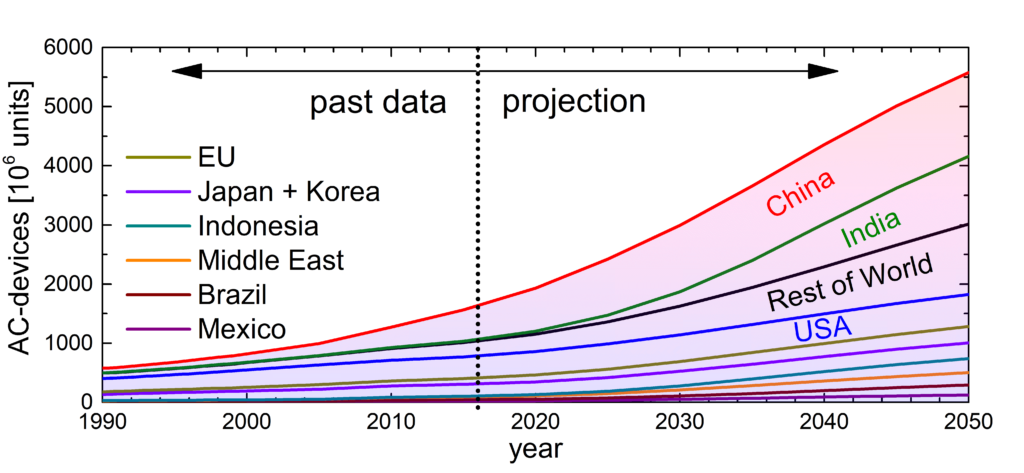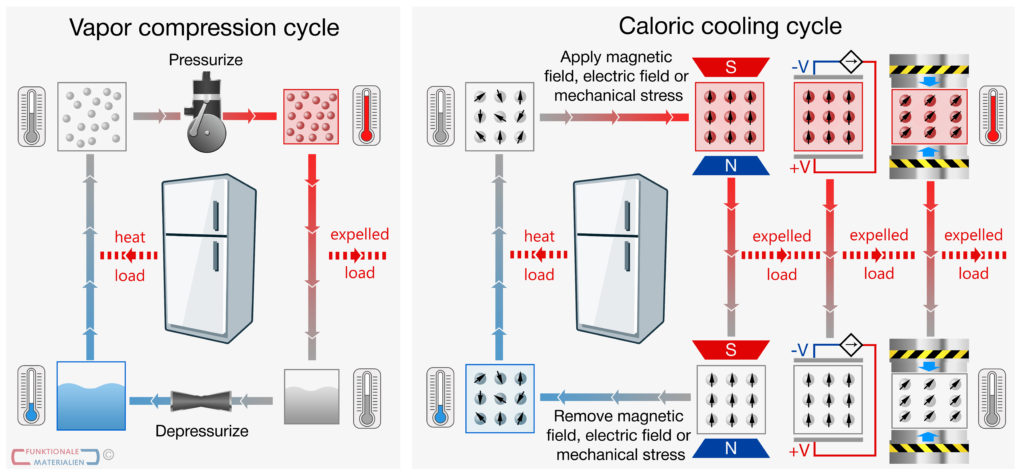World cooling demand
Today a total number of roughly 3 billion devices associated with cooling applications are in use. That covers household, commercial and transport refrigeration, air conditioning systems and heat pumps. It is truly astonishing to recognize that over a long period of time our cooling technology has not changed in its underlying principles and remains based on the vapour compression cycles.
The overall contribution of the refrigeration sector to climate change is frequently overlooked. Nevertheless, it is huge: approximately 12% of total greenhouse gas emissions stem from cooling alone1. This is a combined impact of the direct emission of fluorocarbons and the electricity production needed to operate devices. This also means that at least 17% of the global electricity consumption is required for refrigeration and air-conditioning.
Today’s refrigeration systems are inefficient and use refrigerants with a high global warming potential: in total, more than 4 billion tons of CO2-equivalent are emitted either indirectly through high energy consumption (contributing about 70% to this number) or directly through the leaking refrigerants (the rest). As a consequence, new regulations aim to phase out eco-unfriendly refrigerants within the next 30 years in Europe and around the globe. The problem is that in many cases there are no effective replacements for these soon-to-be outlawed refrigerants, and in some cases explosive or toxic alternative refrigerants are being considered.

Studies predict that the global energy demand for cooling purposes will soon prevail over the energy that is needed for heating3. Apart from the direct consequences of global warming, the main driver is the growing standard of living in fast developing countries located in warm and tropical regions. In 30 years, two-third of all households worldwide are expected to be equipped with air-conditioning systems, while China and India will account for half of them. We are entering, possibly have entered already, a cryogenic age.
Caloric cooling as an alternative to the conventional cycle
In order to overcome the above-mentioned challenges for future cooling technologies, exciting solid-state based new cooling technologies have been proposed. They could provide higher energy efficiencies by using a solid state refrigerant and a simple heat exchange liquid like water. In this case, a thermodynamic cycle can be devised using any material in which an internal degree of freedom can be ordered and disordered. Such materials might have variable magnetic spins, electric dipoles, or structural arrangements. The largest heating and cooling effects will be found in materials that undergo a spontaneous phase transition at the desired temperature. For those special materials, a relatively small driving field can be applied or released around that temperature and tip the thermodynamic balance between one state and another.4

Magnetic refrigeration is probably the most developed of the solid state cooling technologies and has been in focus of intense research since the discovery of giant magnetocaloric effects in the 1990’s. It is based on the magnetocaloric effect — a useful adiabatic temperature change in a substance exposed to a changing magnetic field4. Above the thermodynamic cycle is shown, after completion of which, the reduced temperature of a magnetocaloric material can be used for a temperature exchange with the cooling target (the inside of a fridge, for example) by a heat exchanger setup. The material is then demagnetized and at the temperature where the cycle can start again from the beginning. A typical problem of the solid state refrigerants is that the largest effects are shown by the materials with first-order phase transitions, which have the hysteresis that hinders the efficiency of the material.
At this moment, twenty years of research in magnetocaloric cooling has not yet provided the necessary breakthrough that will lead to a commercial realisation of this technology and satisfy the urgent global need for more efficient refrigeration. We strongly believe that the technology needs also some highly unconventional approaches. Cool Innov rethinks the whole concept of the conventional caloric cooling. Instead of trying to squeeze the best out of magnetostructural phase-change materials in relatively low magnetic fields by attempts of the reduction of the thermal hysteresis, we intend to make use of it by introducing a second stimulus in the form of mechanical load. We are aiming at a revolution in cooling technology which will have a significant impact on global energy consumption.
2 International Energy Agency, The Future of Cooling, IEA, Paris (2018) https://www.iea.org/reports/the-future-of-cooling
3 M. Isaac, D. P. v. Vuuren, Modeling global residential sector energy demand for heating and air conditioning in the context of climate change, Energy Policy (2009) https://doi.org/10.1016/j.enpol.2008.09.051
4 I. Takeuchi, K. Sandeman, Solid-state cooling with caloric materials, Physics Today (2015) https://doi.org/10.1063/PT.3.3022



